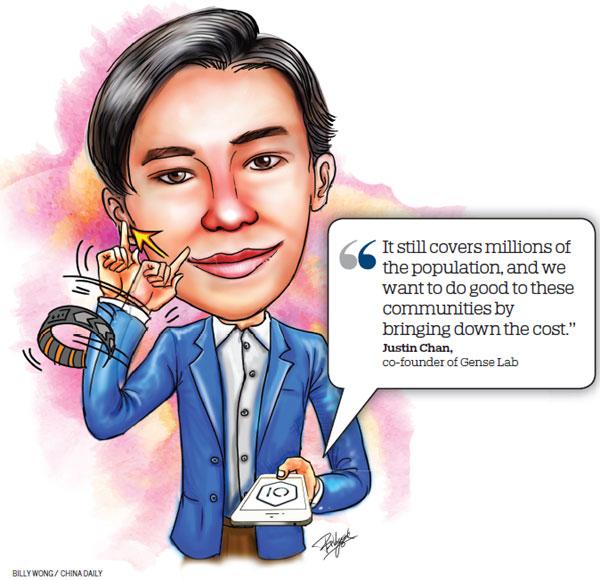Getting the deaf and the mute heard handily
Updated: 2019-03-08 07:02
By Pamela Lin in Hong Kong(HK Edition)
|
|||||||||
Sign language, as one of the main forms of communication for the deaf and mute community, has been getting scant attention which, as a result, has left those with disabilities in interacting with others in the lurch.
The rapid advent of technology, which knows no boundaries, has now rallied behind the disadvantaged, bringing a glimmer of hope for the hearing-and-speech impaired community to help them overcome the communication challenges in their daily lives.
Hong Kong startup Gense Lab is playing that role - bridging the communication gap between the deaf-mute population and others, applying its hand gesture recognition wearable technology, which realizes the translation from sign language to voice messages.
Justin Chan and two co-founders of the company, who majored in electronics and biomedical engineering, got Gense off the ground two years ago when the group of young entrepreneurs decided to integrate medical diagnostics with new technology to create convenience for the community that may not have as much privilege and education as others.
"We identified technology in recognizing hand gestures and we can make it faster, smaller and improve the algorithm with machine learning," says Chan, whose team works on both electronics and biomedical engineering.
Before taking the plunge into the business, the Gense team had been in touch with Hong Kong's deaf and mute residents to get an in-depth understanding of their hearing and speaking impairment.

"We went to meet them to see if such technology can really help," says Chan. "And, to our delight, they told us it would help quite a lot, even with only a hundred or two phrases," says Chan.
On one hand, the technology can detect different hand gestures through the wristband, which has 16 sensors to detect the inner biological tissues, including muscle groups.
Each sensor will send a signal to the other 15 through multiple electrodes that contact the skin, and each of the intersection point corresponds to a data value.
Via the procedural stimulation and back-projection process, a bio-signal web can be created to form a live dynamic bio-image through which the device detects hand gestures with machine learning algorithms carried by an app designed by Gense.
"We've around 120 data points inside the wristband to recognize gestures and make it more accurate," explains Chan.
On the other hand, Gense translates these gestures into voice messages which are played out through an external speaker. The widely used Chinese and American sign languages translation is the main focus for Gense.
"What we're doing right now is to make sure we can get the gestures quite accurately," says Chan.
Starting a business is always challenging, as it is for Chan. He admits it's always tougher in terms of the hardware and looking for investors.
"One of the biggest misconceptions is that whenever we talk to investors or other stakeholders outside the industry, they seem to think it's a very small market where people use sign language as their first language, but there're still about 70 million people who use sign language as their first language, which is really a lot."
According to the World Health Organization, more than 5 percent of the world's population - representing some 466 million people - currently suffer from hearing loss, and the number is projected to surpass 900 million by 2050.
"It still covers millions of the population, and we want to do good to these communities by bringing down the cost," says Chan.
To make it crystallized, Gense joined two programs under Cyberport.
"We were granted HK$100,000 ($13,000) under the Cyberport Creative Micro Fund program, and we used the money to build a very early prototype and also for research," Chan says.
Gense now has a prototype that could recognize tens of hand gestures, and the startup is actively working on faster and more accurate detection.
The startup has joined the Cyberport incubation program which provides up to HK$500,000 in financial assistance to each selected startup, turning their innovative ideas into products and business plans.
To date, Gense has won several innovation awards, including the Asia Social Innovation Award, as well as the grand prize of Hong Kong University DreamCatchers 2018, helping the startup to get funds in the research and development stage.
"As for the future, we'll still be working toward the ultimate goal of sign language translation, and the applications on medical diagnostics and lifestyle are expected to help us raise more funds for R&D," says Chan.
In addition, Gense's sensing technology could be applied in multiple scenarios other than sign language translation, such as in the diagnostic, gaming, training and lifestyle fields.
The gesture recognition technology can detect carpal and cubital tunnel syndrome, early neuropathies, and also in virtual reality and smart-home and smartphone control.
"These applications would enable us to have a longer R&D period as sign language translation is not easy to be done quickly. It takes some time and we need to survive as well," says Chan.
As the sensing technology could be embedded into smart watches and other wearable digital devices, Gense is considering licensing the technology out and teaming up with companies in the gaming and smart-living industries.
According to Chan, Gense has also gone into the manufacturing process, and has started talking to factories to get a plant.
"For hardware design, it's very important that we find something that would work in our lab."
pamelalin@chinadailyhk.com

(HK Edition 03/08/2019 page9)